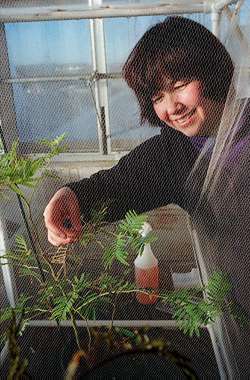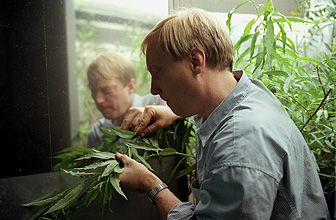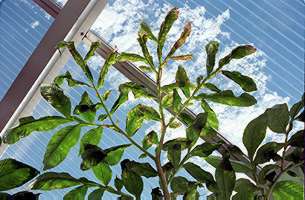Winter Blooms



The Biolabs greenhouse is one of three working greenhouse facilities on the Cambridge campus. The Biolabs facility provides growing space for research plants and living plant collections, while the two other greenhouses were built for specific experimental systems the Organismic and Evolutionary Biology (OEB) glasshouse for studies of the effects of elevated atmospheric carbon dioxide concentrations on biological systems, and the Museum of Comparative Zoology (MCZ) greenhouse for studies of plant and insect interactions.
The end section of the Biolabs greenhouse holds the diversity collections plants are kept as examples of a species, a family, or a commercially important plant. In the collections room, metal tables hold blooming bougainvillea, a small cinnamon plant, a coffee tree, and a carnivorous pitcher plant. A banana tree and a 7-foot leaf called Amorphophallus stretch from the floor to the glass above. These plants come from all over the world, though most are tropical. New plants arrive from trades with other greenhouses and purchases, as well as with scientists who bring plants in for research. “We keep an eye out for new plant groups, economically important plants, different morphology, and unusual pollination strategies,” explains greenhouse manager Richard Stomberg.
The result is a diverse collection and hundreds of plants. Plant grower Janet Sherwood cares for them all, watering, fertilizing, and keeping them free of disease. “You just have to be attentive,” she comments, lightly touching a leaf.
So many healthy and unusual plants provide an essential tool for teaching. “The diversity collections are critical to teaching of undergraduate and graduate courses in diversity and evolution,” comments Michael Donoghue, professor of biology. This spring, Donoghue will teach Biology 103, Plant Diversity, and, he notes, “the collections will figure prominently.” In fact, plants from the Biolabs greenhouse serve as teaching tools for many classes. In teaching Biology 20, Biological Diversity, Associate Professor of Organismic and Evolutionary Biology David Baum uses the collection to “show students the rules of plant structural organization and then to show them the exceptions.” N. Michele Holbrook, the Thomas D. Cabot Associate Professor of Organismic and Evolutionary Biology, recently took students in her class, Biology 120, Physiology of Plants, on a tour. “We looked at examples of what we had talked about during the semester it was a good review.”
The rest of the facility provides growing space for research and class projects. “Its a critical resource for research,” says Holbrook. So critical, that there is very little extra space. One table holds plants from the Winteraceae family, used in studies of physiology. Across another table spread snapdragons, used in studies of floral evolution. Small mangrove trees, which provide data on the physiology of water uptake and salt exclusion, crowd another table. More plants mean more work for Sherwood, but its not unusual. Many faculty, graduate students, and undergraduates have depended on the greenhouse for their research. Donoghue comments, “So many students have used it over the years we couldnt do without it.”
Simulating the Future
Nearby, more research goes on in the OEB glasshouse facility, which sticks out into the parking lot in front of the Andover Theological Library. Inside, large lamps hang from the ceiling like bells. Swags of wires and tubing adorn the thin metal beams that support the glass panels. Round metal fans whir. Composed of six glass rooms, this facility was designed by Mallinckrodt Professor of Biology Fakhri Bazzaz for research on the effects of increasing carbon dioxide (CO2) concentrations. Currently, CO2 concentrations, which are increasing in the earths atmosphere because of the burning of fossil fuels, are contributing to the well-publicized “greenhouse effect.” Scientists may disagree about what the specific effects of this increase will be, but most agree that it should be studied. The glasshouse provides excellent space for such studies because the environment can be carefully controlled temperature, light, and CO2. “By doubling the CO2 concentration, or raising the temperature, we can set the greenhouse environment to simulate the future,” explains Bazzaz.
Since plants absorb CO2 as they grow, turning the carbon into their leaves, stems, roots, flowers, and wood, rising CO2 concentrations can have significant consequences. In the OEB glasshouse, a tangle of African savanna trees reaches almost 4 feet in a room with elevated levels of CO2. On the other side of the glass wall, in ambient CO2 concentrations, the same trees reach only to 2 feet. Greenhouse manager Stomberg notes, “that kind of fertilization effect is not unexpected,” but its not consistent for all plants. Bazzaz elaborates: “One of the interesting findings is that plants from the same ecosystem can respond quite differently to increased CO2. Some plants stop responding while others continue over the course of years.” With some plants getting bigger, faster, “we may end up with only those species which do respond to higher CO2 and that would produce a startling result increased production, but reduced diversity,” explains Bazzaz.
Since it was built in 1986, the facility has been used extensively to study this and other problems. “Weve grown annuals, tree seedlings, grasses, oaks from Florida, African savanna species, and tropical trees as well,” Bazzaz says. Studies conducted in the OEB glasshouse have examined changes in photosynthetic activity, growth, allocation, morphology, and timing of reproduction, and have resulted in hundreds of publications. “Weve had a lot of visitors from abroad come to do experiments from Japan, England, Switzerland, Malaysia, Spain,” Bazzaz points out. With less distance to travel, many graduate and undergraduate students have also used the glasshouse for experiments.
As greenhouse manager, Stomberg must not only keep the plants thriving, but also must maintain consistent experimental conditions. Helping Stomberg is a sophisticated monitoring and control system. “Everything you see here is run by computers light, temperature, CO2 injection they even run the boiler,” comments Stomberg. An infrared gas analyzer measures the CO2 levels in the air of each chamber every two minutes and sends it to a computer. The computer takes the data, analyzes it, and, if concentrations are too low, sends a signal to inject CO2 into the room. The CO2 comes from a closet full of compressed gas cylinders. Stomberg pats a tank, “Pure liquid CO2 the same stuff used to make soft drinks.” The high-tech system enables high-tech research.
Ants in the Plants at the MCZ Greenhouse
Research also thrives in the MCZ greenhouse, on top of the Museum of Comparative Zoology lab building. Unlike the other two greenhouses, this facility specializes in growing insects and the plants they feed upon. Designed by Naomi Pierce, Hessel Professor of Biology and Curator of Lepidoptera, the MCZ greenhouse serves as a feeding ground for many species of ants and butterflies from the Lycaenidae family. The feathery leaves of acacia trees, fodder for the burgeoning insect populations, fill much of the glassed-in space.
For nearly 20 years, Pierce has been studying the associations between ants and lycaenid butterflies, mostly native to Australia. Essentially, the ants and the butterflies cooperate “the caterpillars secrete food for the ants from special glands, and in return, the ants protect them from parasites and predators,” explains Pierce. With the caterpillars feeding on the acacia trees, “its a three-level interaction.”
On a walk though the facility, greenhouse manager Jennifer Mills approaches a tent of white mesh that covers one acacia tree. She flicks the soft mesh wall and a small butterfly lifts off, flitters for a moment and settles in a new spot. “These are Jalmenus evagoras, or Imperial Blue,” she explains. Theyre laying eggs on the acacia inside, to keep their greenhouse population going. Mills plucks a brown spiky caterpillar from a neighboring plant and gently cradles it in the palm of her hand “they make vibrations, which travel through the leaves” as a way to communicate with the ants. This subtle sound can be magnified. “If you take a bunch of pupae, put them in a film canister, and shake it, you can hear them clicking and rattling against the sides,” explains Pierce.
Currently, its a quiet time in the MCZ greenhouse, because no large experiments are under way. Taking advantage of Australias summer, some students are studying the butterflies native habitat. “Its very boom or bust the house fills with an experiment, and then when its done, theres less activity,” says Pierce. But over the years, many projects have filled the space, including both graduate and undergraduate student research projects. As a result, Pierce and her collaborators have learned much about the ant-lycaenid system caterpillars can’t survive without ants in the wild, female butterflies can discriminate between different ant species, and caterpillars secreting sugars and amino acids for the ants prefer to forage on the nitrogen-rich growing tips of leaves. “The system has proved to be a model for analyzing plant/insect interactions, chemical communication, conservation biology, and the evolution of complex life history traits,” comments Pierce.
But the discoveries will not stop there. Theres more to know, and in another section of the greenhouse, Pierce and her collaborator from Harvard Medical School, Fred Ausubel, are growing plants for a new series of studies. Spreading out like a lawn, the delicate oval leaves of Arabidopsis thaliana hug the soil in their pots. They’re fodder for the cabbage looper, a pest that feeds on commercially important plants like alfalfa, celery, and tomatoes. Graduate student, Paul Kim explains, “Were interested in the genetics of plant-insect interactions, and the genetics of Arabidopsis are really well studied.” By growing plants with known mutations, the researchers can examine the effects of specific genes on plant responses to foraging insects. “The project will help us to understand the genetic basis of resistance by plants to insect attack, and it has some practical benefits as well,” comments Pierce.
So, research continues in all these greenhouses on the Cambridge campus. Plants grow, insects munch leaves, and flowers bloom even in the cold of January.




